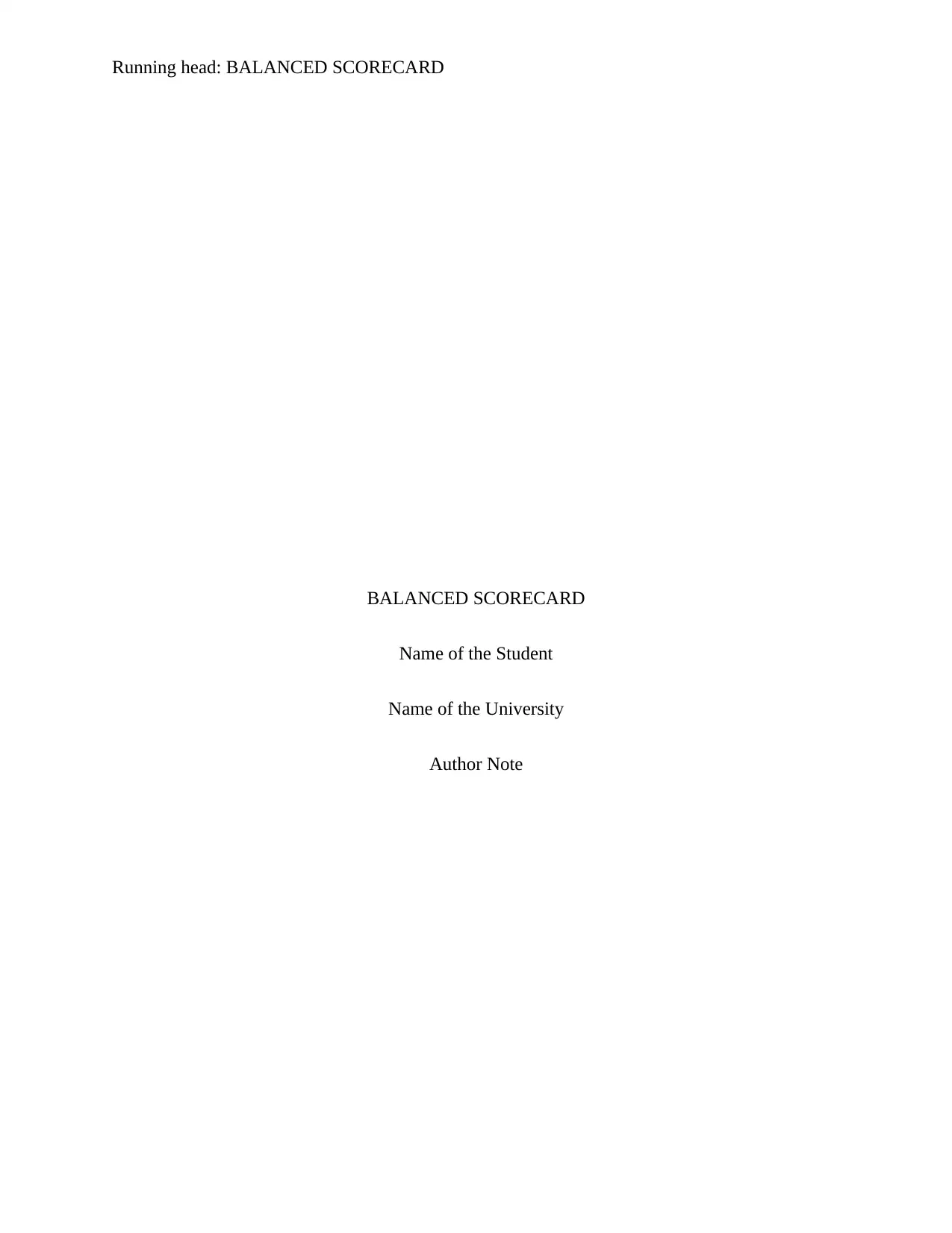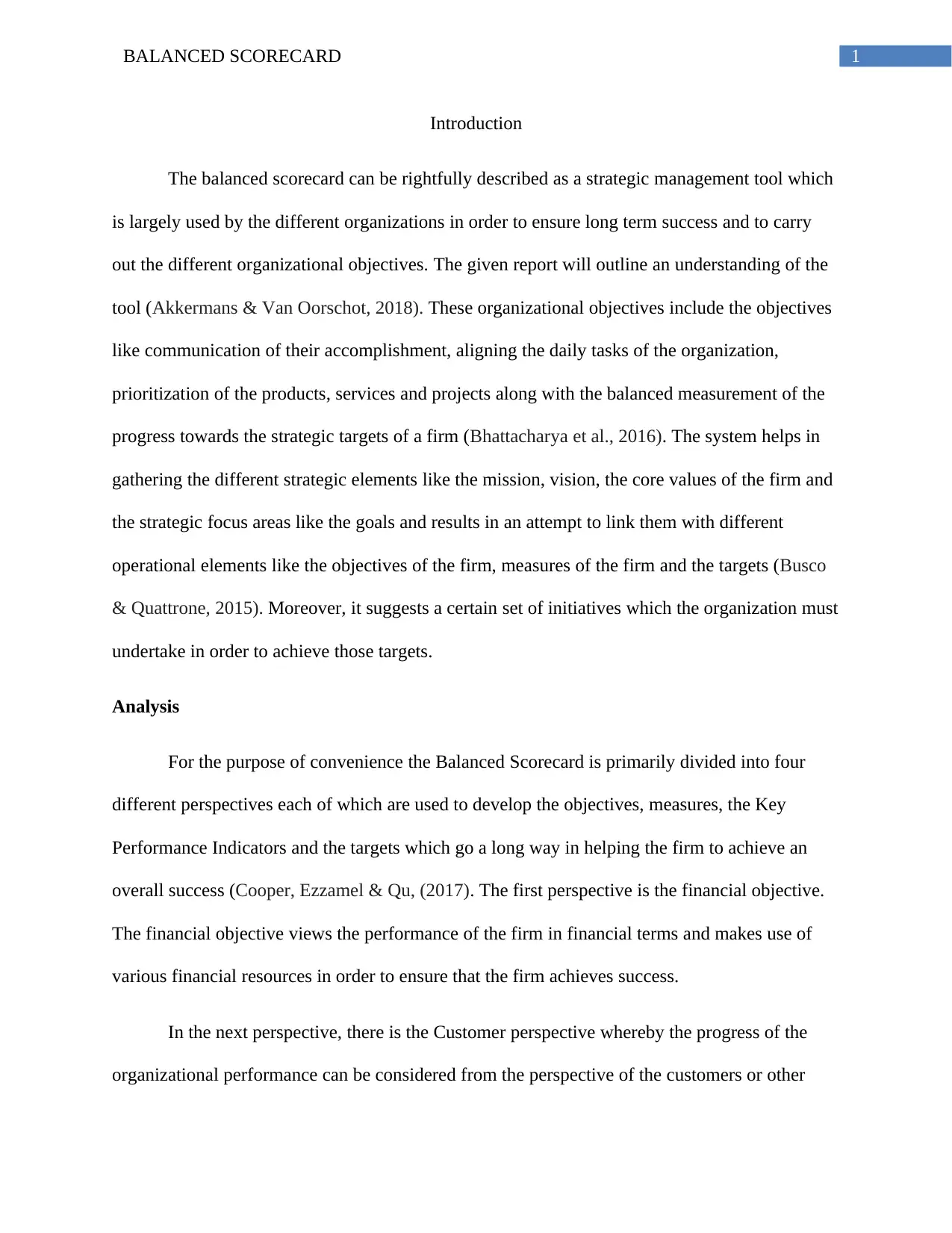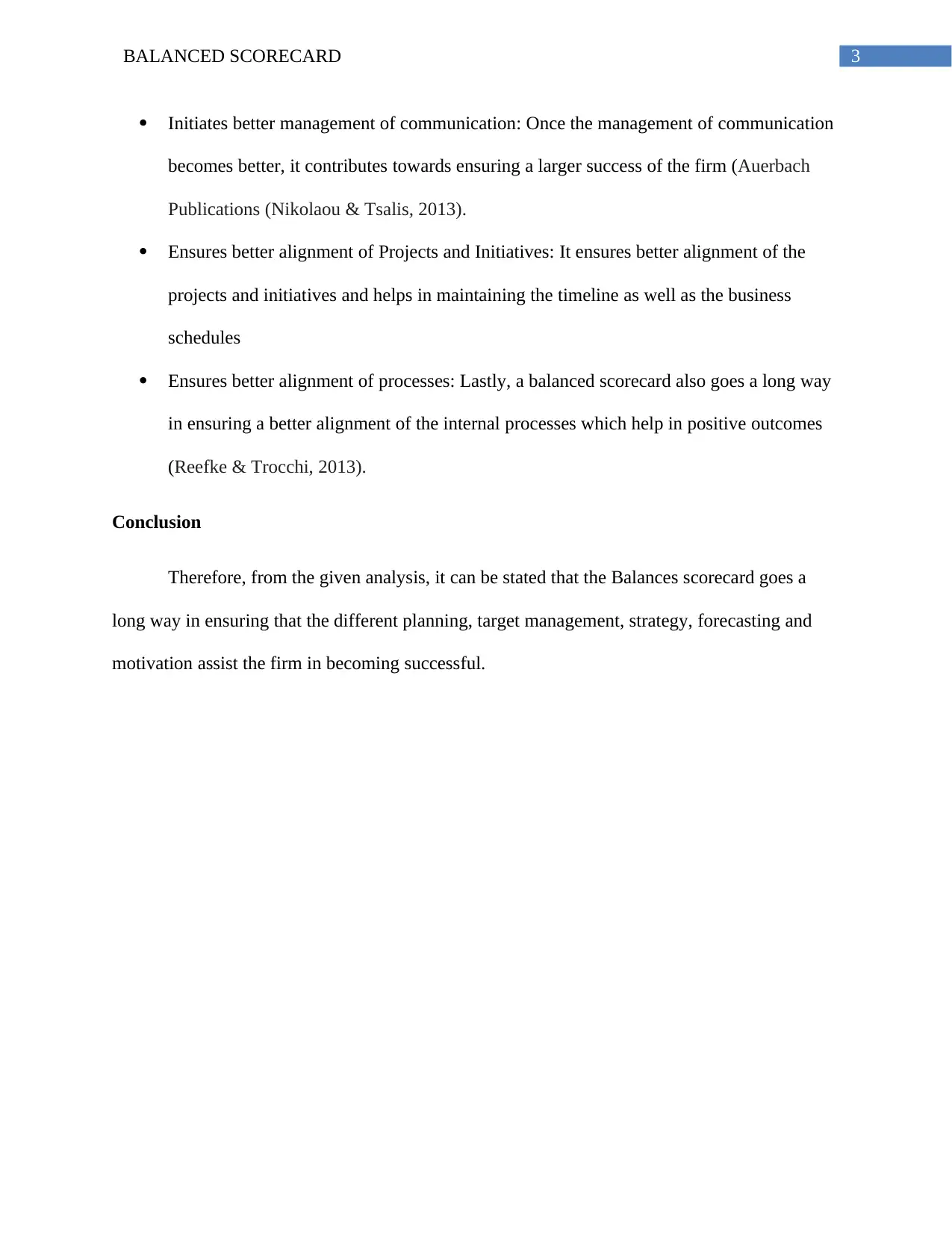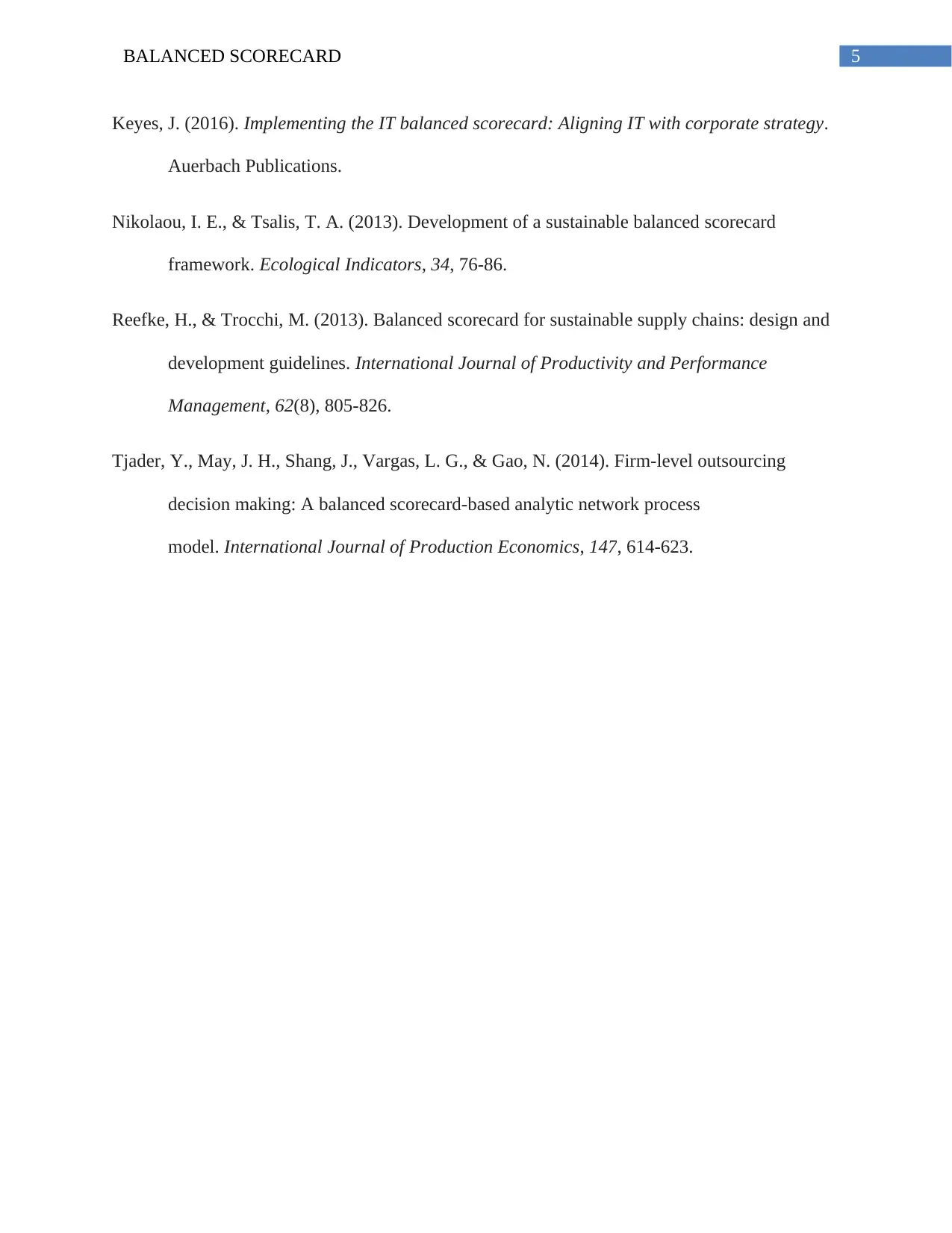Balanced Scorecard: Strategic Planning, Implementation, and Analysis
VerifiedAdded on 2023/06/03
|6
|1267
|110
Report
AI Summary
This report provides a comprehensive overview of the Balanced Scorecard, a strategic management tool designed to ensure long-term organizational success. It outlines the tool's objectives, including communicating accomplishments, aligning tasks, and prioritizing projects. The report divides the Balanced Scorecard into four key perspectives: financial, customer, internal process, and organizational capacity. It explores the relationship between the Balanced Scorecard and strategic planning, communication, and project alignment. The analysis highlights how the Balanced Scorecard helps increase revenue, improve customer experience, and enhance cost efficiency. The report concludes by emphasizing the tool's role in facilitating successful planning, target management, strategy, and motivation within an organization, supported by references to relevant academic sources.

Running head: BALANCED SCORECARD
BALANCED SCORECARD
Name of the Student
Name of the University
Author Note
BALANCED SCORECARD
Name of the Student
Name of the University
Author Note
Paraphrase This Document
Need a fresh take? Get an instant paraphrase of this document with our AI Paraphraser

1BALANCED SCORECARD
Introduction
The balanced scorecard can be rightfully described as a strategic management tool which
is largely used by the different organizations in order to ensure long term success and to carry
out the different organizational objectives. The given report will outline an understanding of the
tool (Akkermans & Van Oorschot, 2018). These organizational objectives include the objectives
like communication of their accomplishment, aligning the daily tasks of the organization,
prioritization of the products, services and projects along with the balanced measurement of the
progress towards the strategic targets of a firm (Bhattacharya et al., 2016). The system helps in
gathering the different strategic elements like the mission, vision, the core values of the firm and
the strategic focus areas like the goals and results in an attempt to link them with different
operational elements like the objectives of the firm, measures of the firm and the targets (Busco
& Quattrone, 2015). Moreover, it suggests a certain set of initiatives which the organization must
undertake in order to achieve those targets.
Analysis
For the purpose of convenience the Balanced Scorecard is primarily divided into four
different perspectives each of which are used to develop the objectives, measures, the Key
Performance Indicators and the targets which go a long way in helping the firm to achieve an
overall success (Cooper, Ezzamel & Qu, (2017). The first perspective is the financial objective.
The financial objective views the performance of the firm in financial terms and makes use of
various financial resources in order to ensure that the firm achieves success.
In the next perspective, there is the Customer perspective whereby the progress of the
organizational performance can be considered from the perspective of the customers or other
Introduction
The balanced scorecard can be rightfully described as a strategic management tool which
is largely used by the different organizations in order to ensure long term success and to carry
out the different organizational objectives. The given report will outline an understanding of the
tool (Akkermans & Van Oorschot, 2018). These organizational objectives include the objectives
like communication of their accomplishment, aligning the daily tasks of the organization,
prioritization of the products, services and projects along with the balanced measurement of the
progress towards the strategic targets of a firm (Bhattacharya et al., 2016). The system helps in
gathering the different strategic elements like the mission, vision, the core values of the firm and
the strategic focus areas like the goals and results in an attempt to link them with different
operational elements like the objectives of the firm, measures of the firm and the targets (Busco
& Quattrone, 2015). Moreover, it suggests a certain set of initiatives which the organization must
undertake in order to achieve those targets.
Analysis
For the purpose of convenience the Balanced Scorecard is primarily divided into four
different perspectives each of which are used to develop the objectives, measures, the Key
Performance Indicators and the targets which go a long way in helping the firm to achieve an
overall success (Cooper, Ezzamel & Qu, (2017). The first perspective is the financial objective.
The financial objective views the performance of the firm in financial terms and makes use of
various financial resources in order to ensure that the firm achieves success.
In the next perspective, there is the Customer perspective whereby the progress of the
organizational performance can be considered from the perspective of the customers or other

2BALANCED SCORECARD
crucial stakeholders which the organization primarily serves (Gibbons & Kaplan, 2015). The
third perspective is the internal process perspective which aims to view the organization from the
point of view of the quality of the internal products and the manner in which the processes are
carried out in the organization (Hoque, 2014). The last perspective is the capacity of the
organization or the Organizational capacity or Learning and Growth perspective which helps in
the understanding of the performance of a firm from the point of view of the technology
employed, human capital of the firm, the infrastructure and other related capacities.
Having understood the basic concept behind the Balanced scorecard, it is very important
to understand the relationship of the of the Balanced scorecard with the different aspects like that
of planning, strategies, motivation and cybernetic effects in order to ensure that the tool is
suitable for the organization at large (Kang et al., 2015). The most important aspect of the
balanced scorecard is that it helps to formulate different strategies which then helps the firm to
increase revenue, improve the customer as well as stakeholder experience and ensure that the
different organizational members are able to improve the cost efficiency of the firm at large
(Tjader et al., 2014).
Along with this, the balanced scorecard is related to various other elements of the firm in
the following manner:
It improves strategic planning: It ensures that the organization is able to make the
different decisions in advance which ensure successful strategic planning (Keyes, 2016).
Improves communication: It improves the communication which takes place in the
organization so as to ensure that the comfort level of the different employees improve and
bonding exists.
crucial stakeholders which the organization primarily serves (Gibbons & Kaplan, 2015). The
third perspective is the internal process perspective which aims to view the organization from the
point of view of the quality of the internal products and the manner in which the processes are
carried out in the organization (Hoque, 2014). The last perspective is the capacity of the
organization or the Organizational capacity or Learning and Growth perspective which helps in
the understanding of the performance of a firm from the point of view of the technology
employed, human capital of the firm, the infrastructure and other related capacities.
Having understood the basic concept behind the Balanced scorecard, it is very important
to understand the relationship of the of the Balanced scorecard with the different aspects like that
of planning, strategies, motivation and cybernetic effects in order to ensure that the tool is
suitable for the organization at large (Kang et al., 2015). The most important aspect of the
balanced scorecard is that it helps to formulate different strategies which then helps the firm to
increase revenue, improve the customer as well as stakeholder experience and ensure that the
different organizational members are able to improve the cost efficiency of the firm at large
(Tjader et al., 2014).
Along with this, the balanced scorecard is related to various other elements of the firm in
the following manner:
It improves strategic planning: It ensures that the organization is able to make the
different decisions in advance which ensure successful strategic planning (Keyes, 2016).
Improves communication: It improves the communication which takes place in the
organization so as to ensure that the comfort level of the different employees improve and
bonding exists.
⊘ This is a preview!⊘
Do you want full access?
Subscribe today to unlock all pages.

Trusted by 1+ million students worldwide

3BALANCED SCORECARD
Initiates better management of communication: Once the management of communication
becomes better, it contributes towards ensuring a larger success of the firm (Auerbach
Publications (Nikolaou & Tsalis, 2013).
Ensures better alignment of Projects and Initiatives: It ensures better alignment of the
projects and initiatives and helps in maintaining the timeline as well as the business
schedules
Ensures better alignment of processes: Lastly, a balanced scorecard also goes a long way
in ensuring a better alignment of the internal processes which help in positive outcomes
(Reefke & Trocchi, 2013).
Conclusion
Therefore, from the given analysis, it can be stated that the Balances scorecard goes a
long way in ensuring that the different planning, target management, strategy, forecasting and
motivation assist the firm in becoming successful.
Initiates better management of communication: Once the management of communication
becomes better, it contributes towards ensuring a larger success of the firm (Auerbach
Publications (Nikolaou & Tsalis, 2013).
Ensures better alignment of Projects and Initiatives: It ensures better alignment of the
projects and initiatives and helps in maintaining the timeline as well as the business
schedules
Ensures better alignment of processes: Lastly, a balanced scorecard also goes a long way
in ensuring a better alignment of the internal processes which help in positive outcomes
(Reefke & Trocchi, 2013).
Conclusion
Therefore, from the given analysis, it can be stated that the Balances scorecard goes a
long way in ensuring that the different planning, target management, strategy, forecasting and
motivation assist the firm in becoming successful.
Paraphrase This Document
Need a fresh take? Get an instant paraphrase of this document with our AI Paraphraser

4BALANCED SCORECARD
References
Akkermans, H. A., & Van Oorschot, K. E. (2018). Relevance assumed: a case study of balanced
scorecard development using system dynamics. In System Dynamics (pp. 107-132).
Palgrave Macmillan, London.
Bhattacharya, A., Mohapatra, P., Kumar, V., Dey, P. K., Brady, M., Tiwari, M. K., &
Nudurupati, S. S. (2014). Green supply chain performance measurement using fuzzy
ANP-based balanced scorecard: a collaborative decision-making approach. Production
Planning & Control, 25(8), 698-714.
Busco, C., & Quattrone, P. (2015). Exploring how the Balanced Scorecard engages and unfolds:
Articulating the visual power of accounting inscriptions. Contemporary Accounting
Research, 32(3), 1236-1262.
Cooper, D. J., Ezzamel, M., & Qu, S. Q. (2017). Popularizing a management accounting idea:
The case of the balanced scorecard. Contemporary Accounting Research, 34(2), 991-
1025.
Gibbons, R., & Kaplan, R. S. (2015). Formal Measures in Informal Management: Can a
Balanced Scorecard Change a Culture?. American Economic Review, 105(5), 447-51.
Hoque, Z. (2014). 20 years of studies on the balanced scorecard: trends, accomplishments, gaps
and opportunities for future research. The British accounting review, 46(1), 33-59.
Kang, J. S., Chiang, C. F., Huangthanapan, K., & Downing, S. (2015). Corporate social
responsibility and sustainability balanced scorecard: The case study of family-owned
hotels. International Journal of Hospitality Management, 48, 124-134.
References
Akkermans, H. A., & Van Oorschot, K. E. (2018). Relevance assumed: a case study of balanced
scorecard development using system dynamics. In System Dynamics (pp. 107-132).
Palgrave Macmillan, London.
Bhattacharya, A., Mohapatra, P., Kumar, V., Dey, P. K., Brady, M., Tiwari, M. K., &
Nudurupati, S. S. (2014). Green supply chain performance measurement using fuzzy
ANP-based balanced scorecard: a collaborative decision-making approach. Production
Planning & Control, 25(8), 698-714.
Busco, C., & Quattrone, P. (2015). Exploring how the Balanced Scorecard engages and unfolds:
Articulating the visual power of accounting inscriptions. Contemporary Accounting
Research, 32(3), 1236-1262.
Cooper, D. J., Ezzamel, M., & Qu, S. Q. (2017). Popularizing a management accounting idea:
The case of the balanced scorecard. Contemporary Accounting Research, 34(2), 991-
1025.
Gibbons, R., & Kaplan, R. S. (2015). Formal Measures in Informal Management: Can a
Balanced Scorecard Change a Culture?. American Economic Review, 105(5), 447-51.
Hoque, Z. (2014). 20 years of studies on the balanced scorecard: trends, accomplishments, gaps
and opportunities for future research. The British accounting review, 46(1), 33-59.
Kang, J. S., Chiang, C. F., Huangthanapan, K., & Downing, S. (2015). Corporate social
responsibility and sustainability balanced scorecard: The case study of family-owned
hotels. International Journal of Hospitality Management, 48, 124-134.

5BALANCED SCORECARD
Keyes, J. (2016). Implementing the IT balanced scorecard: Aligning IT with corporate strategy.
Auerbach Publications.
Nikolaou, I. E., & Tsalis, T. A. (2013). Development of a sustainable balanced scorecard
framework. Ecological Indicators, 34, 76-86.
Reefke, H., & Trocchi, M. (2013). Balanced scorecard for sustainable supply chains: design and
development guidelines. International Journal of Productivity and Performance
Management, 62(8), 805-826.
Tjader, Y., May, J. H., Shang, J., Vargas, L. G., & Gao, N. (2014). Firm-level outsourcing
decision making: A balanced scorecard-based analytic network process
model. International Journal of Production Economics, 147, 614-623.
Keyes, J. (2016). Implementing the IT balanced scorecard: Aligning IT with corporate strategy.
Auerbach Publications.
Nikolaou, I. E., & Tsalis, T. A. (2013). Development of a sustainable balanced scorecard
framework. Ecological Indicators, 34, 76-86.
Reefke, H., & Trocchi, M. (2013). Balanced scorecard for sustainable supply chains: design and
development guidelines. International Journal of Productivity and Performance
Management, 62(8), 805-826.
Tjader, Y., May, J. H., Shang, J., Vargas, L. G., & Gao, N. (2014). Firm-level outsourcing
decision making: A balanced scorecard-based analytic network process
model. International Journal of Production Economics, 147, 614-623.
⊘ This is a preview!⊘
Do you want full access?
Subscribe today to unlock all pages.

Trusted by 1+ million students worldwide
1 out of 6
Related Documents
Your All-in-One AI-Powered Toolkit for Academic Success.
+13062052269
info@desklib.com
Available 24*7 on WhatsApp / Email
![[object Object]](/_next/static/media/star-bottom.7253800d.svg)
Unlock your academic potential
Copyright © 2020–2025 A2Z Services. All Rights Reserved. Developed and managed by ZUCOL.





